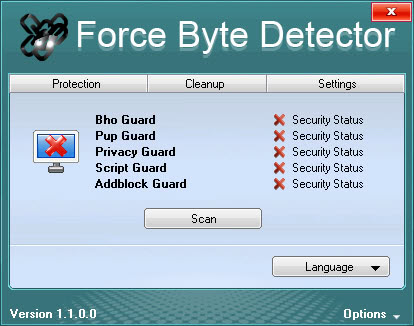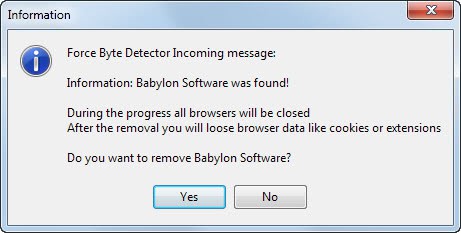Force Byte Detector: remove toolbars and other PUPs from your Windows PC

At least some toolbars back in the early days of the Internet offered functionality that you could not really get elsewhere. Google's Toolbar offered translation and Pagerank information for example. Nowadays, features are either integrated in browser's natively or readily available in form of add-ons or web services.
Toolbars in particular and other potentially unwanted programs (PUP) are mainly used to generate revenue these days. This is done either indirectly, by integrating custom search engines into the toolbar and modifying the browser's home page and core search engine as well, or directly by tracking users on the Internet.
If you look around, you will notice that support forums are filled with user questions on how to get rid of a program that has integrated itself into a browser o the computer system.
Programs like Avast's Browser Cleanup Tool, Toolbar Cleaner, or Adware Cleaner provide you with the means to remove all unwanted toolbars from the system in a single run.
And tools like Win Patrol protect your system from these installations in the first place, provided that you block them when they are noticed.
Force Byte Detector
The free program Force Byte Detector combines cleanup and protection. You can run the program right after you have downloaded it to your system.
You get an option to check for updates right on start which you should do. You are then taken to the protection tab where the security status of the protection and a scan button are displayed to you.
A click on scan starts a system wide scan for toolbars, unwanted programs, scripts or Browser Helper Objects that are classified as adware.
You get a prompt for some item that the program finds. Here you are informed about the software that has been found, potential impact on the system if you go ahead with the removal, and options to completely remove the found application from the system or leave it for the time being.
Other programs may be removed automatically from the system without further user input or control over the process. That's a problem as it gives users no control over the removal process.
You can enable the protections under settings in the program interface. According to the program website, these "guards" protect the system against all kinds of threats including toolbars, potentially unwanted programs, Browser Helper Objects, or scripts and ads.
This works on a global level, so that you benefit from ad blocking in all web browsers for example. It is very likely that - at least part of - the functionality is powered by the blocking of IP addresses and domains.
The program ships with a third option, a basic cleanup feature that you can use to remove temporary files and data. It is not as complete as what system cleaners such as CCleaner have to offer though.
Verdict
The program takes good care of toolbars and unwanted programs, and is a great choice if you want them all removed. It lacks control on the other hand which is definitely problematic as it may uninstall programs from the system that you may want to keep.
Advertisement

















I found Force Byte Detector to be an intriguing program that I felt compelled to download as having been the victim of too many incidents in which unauthorized downloads, toolbars would appear without prior knowledge.
I downloaded the program on both of my computers and unsurprisingly they detected several remnants of passed toolbars still lurking on my computer. Having uninstalled toolbars like Conduit, Babylon, other potential malware programs without the slightest fanare, identifying the toolbars but not following it up with any additional information.It then appeared on my Desktop for the longest time, not conveying the slightest indication of what it was doing, what it might be up to up to.
After awhile of no activity whatsoever, I became concerned that it itself was some form of malware and shut my computers down to avoid any perceived risk. When restarting both computers it seemed that the malware it identified as removed but still my fear remained.
I was wondering if this was the normal mode of operation for Force Byte Doctor to appear as if nothing was going on, without any sort of message as to the current status of the porgram’s progress.
Any assistance or clarification of this matter would be greatly appreciated.
Finally I m happy that there are still developers care about anoying toolbars
However I already used ADWcleaner and sometimes junkware removal tool
I m not happy that this program does not give you full control since it removes some software
automatically..
But I will give this one a try
[EDIT]
It seems it does not longer automatically remove Adware in the new version
They give you control over the detected software if you want to remove it just like the toolbars
I just saw they released a new version 1.1.0.3
It is a pretty good software did a few tests the detection was fast.
This will be my third anti adware software incase I have any problems
Without selectivity it is hostile junkware. I wouldn’t touch it with a ten foot pole since it doesn’t allow itemized selection and tell the detailed consequences of removing each item.
“After the removal you will lose browser data like cookies or extensions.”
“Yes No”
Who in their right mind would select “Yes”? I’m rather attached to my extensions. If they had bothered to be specific about what I will “lose” after the removal it might be different but I wouldn’t trust them now or in any future version given that they’ve shown themselves to be this stupid.
I love this software it is pretty useful
so far not really any problems encountered.
It removed browser defender from my computer which I didnt knew I had it on my computer :D
This is a bad software!
It deleted all my firfox profiles and rest incredimail data!
Thanks Martin, For your informative article. Hopefully I will never need it but its good to have this program in main tool belt in case I will need it.
How about Junkware Removal Tool?
What is your favorite one?
I prefer to remove toolbars manually.
YOU ARE SO RIGHT, Mr. Brinkmann!
(removing toolbars and pups manually is the only sure-fire way to rid these things)
hhmm looks very interesting…. ths mate
But I prefer Junkware Removal tool….how about you?
Another good one is this:
http://www.anti-toolbar.com/solution.php